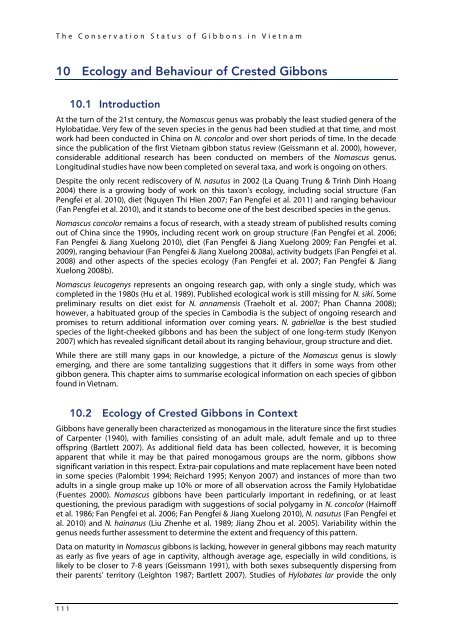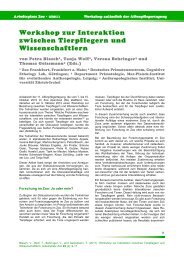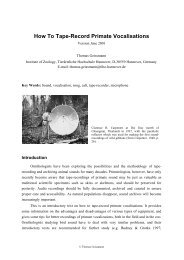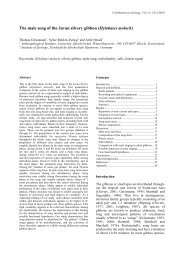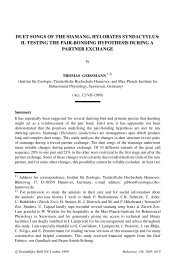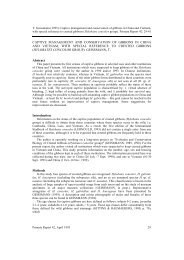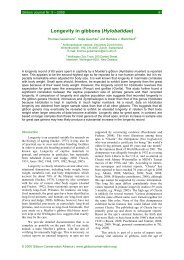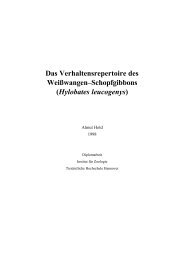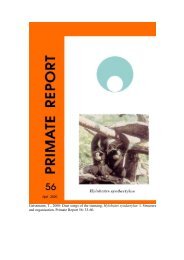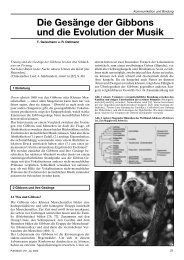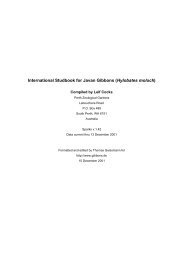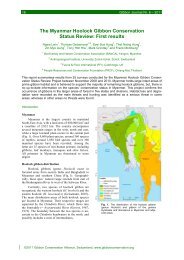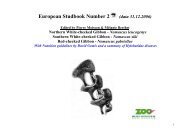The Conservation Status of Gibbons in Vietnam - Gibbon Research ...
The Conservation Status of Gibbons in Vietnam - Gibbon Research ...
The Conservation Status of Gibbons in Vietnam - Gibbon Research ...
Create successful ePaper yourself
Turn your PDF publications into a flip-book with our unique Google optimized e-Paper software.
<strong>The</strong> <strong>Conservation</strong> <strong>Status</strong> <strong>of</strong> <strong><strong>Gibbon</strong>s</strong> <strong>in</strong> <strong>Vietnam</strong>10 Ecology and Behaviour <strong>of</strong> Crested <strong><strong>Gibbon</strong>s</strong>10.1 IntroductionAt the turn <strong>of</strong> the 21st century, the Nomascus genus was probably the least studied genera <strong>of</strong> theHylobatidae. Very few <strong>of</strong> the seven species <strong>in</strong> the genus had been studied at that time, and mostwork had been conducted <strong>in</strong> Ch<strong>in</strong>a on N. concolor and over short periods <strong>of</strong> time. In the decades<strong>in</strong>ce the publication <strong>of</strong> the first <strong>Vietnam</strong> gibbon status review (Geissmann et al. 2000), however,considerable additional research has been conducted on members <strong>of</strong> the Nomascus genus.Longitud<strong>in</strong>al studies have now been completed on several taxa, and work is ongo<strong>in</strong>g on others.Despite the only recent rediscovery <strong>of</strong> N. nasutus <strong>in</strong> 2002 (La Quang Trung & Tr<strong>in</strong>h D<strong>in</strong>h Hoang2004) there is a grow<strong>in</strong>g body <strong>of</strong> work on this taxon’s ecology, <strong>in</strong>clud<strong>in</strong>g social structure (FanPengfei et al. 2010), diet (Nguyen Thi Hien 2007; Fan Pengfei et al. 2011) and rang<strong>in</strong>g behaviour(Fan Pengfei et al. 2010), and it stands to become one <strong>of</strong> the best described species <strong>in</strong> the genus.Nomascus concolor rema<strong>in</strong>s a focus <strong>of</strong> research, with a steady stream <strong>of</strong> published results com<strong>in</strong>gout <strong>of</strong> Ch<strong>in</strong>a s<strong>in</strong>ce the 1990s, <strong>in</strong>clud<strong>in</strong>g recent work on group structure (Fan Pengfei et al. 2006;Fan Pengfei & Jiang Xuelong 2010), diet (Fan Pengfei & Jiang Xuelong 2009; Fan Pengfei et al.2009), rang<strong>in</strong>g behaviour (Fan Pengfei & Jiang Xuelong 2008a), activity budgets (Fan Pengfei et al.2008) and other aspects <strong>of</strong> the species ecology (Fan Pengfei et al. 2007; Fan Pengfei & JiangXuelong 2008b).Nomascus leucogenys represents an ongo<strong>in</strong>g research gap, with only a s<strong>in</strong>gle study, which wascompleted <strong>in</strong> the 1980s (Hu et al. 1989). Published ecological work is still miss<strong>in</strong>g for N. siki. Someprelim<strong>in</strong>ary results on diet exist for N. annamensis (Traeholt et al. 2007; Phan Channa 2008);however, a habituated group <strong>of</strong> the species <strong>in</strong> Cambodia is the subject <strong>of</strong> ongo<strong>in</strong>g research andpromises to return additional <strong>in</strong>formation over com<strong>in</strong>g years. N. gabriellae is the best studiedspecies <strong>of</strong> the light-cheeked gibbons and has been the subject <strong>of</strong> one long-term study (Kenyon2007) which has revealed significant detail about its rang<strong>in</strong>g behaviour, group structure and diet.While there are still many gaps <strong>in</strong> our knowledge, a picture <strong>of</strong> the Nomascus genus is slowlyemerg<strong>in</strong>g, and there are some tantaliz<strong>in</strong>g suggestions that it differs <strong>in</strong> some ways from othergibbon genera. This chapter aims to summarise ecological <strong>in</strong>formation on each species <strong>of</strong> gibbonfound <strong>in</strong> <strong>Vietnam</strong>.10.2 Ecology <strong>of</strong> Crested <strong><strong>Gibbon</strong>s</strong> <strong>in</strong> Context<strong><strong>Gibbon</strong>s</strong> have generally been characterized as monogamous <strong>in</strong> the literature s<strong>in</strong>ce the first studies<strong>of</strong> Carpenter (1940), with families consist<strong>in</strong>g <strong>of</strong> an adult male, adult female and up to three<strong>of</strong>fspr<strong>in</strong>g (Bartlett 2007). As additional field data has been collected, however, it is becom<strong>in</strong>gapparent that while it may be that paired monogamous groups are the norm, gibbons showsignificant variation <strong>in</strong> this respect. Extra-pair copulations and mate replacement have been noted<strong>in</strong> some species (Palombit 1994; Reichard 1995; Kenyon 2007) and <strong>in</strong>stances <strong>of</strong> more than twoadults <strong>in</strong> a s<strong>in</strong>gle group make up 10% or more <strong>of</strong> all observation across the Family Hylobatidae(Fuentes 2000). Nomascus gibbons have been particularly important <strong>in</strong> redef<strong>in</strong><strong>in</strong>g, or at leastquestion<strong>in</strong>g, the previous paradigm with suggestions <strong>of</strong> social polygamy <strong>in</strong> N. concolor (Haim<strong>of</strong>fet al. 1986; Fan Pengfei et al. 2006; Fan Pengfei & Jiang Xuelong 2010), N. nasutus (Fan Pengfei etal. 2010) and N. ha<strong>in</strong>anus (Liu Zhenhe et al. 1989; Jiang Zhou et al. 2005). Variability with<strong>in</strong> thegenus needs further assessment to determ<strong>in</strong>e the extent and frequency <strong>of</strong> this pattern.Data on maturity <strong>in</strong> Nomascus gibbons is lack<strong>in</strong>g, however <strong>in</strong> general gibbons may reach maturityas early as five years <strong>of</strong> age <strong>in</strong> captivity, although average age, especially <strong>in</strong> wild conditions, islikely to be closer to 7-8 years (Geissmann 1991), with both sexes subsequently dispers<strong>in</strong>g fromtheir parents’ territory (Leighton 1987; Bartlett 2007). Studies <strong>of</strong> Hylobates lar provide the only111


